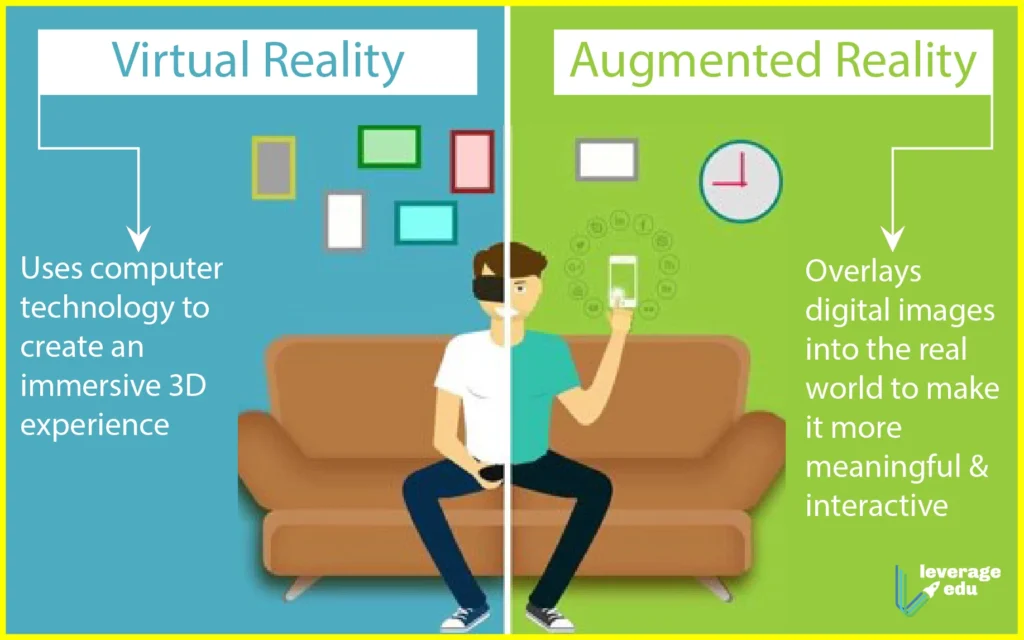Augmented Reality and Virtual Reality are two popular technologies that have been gaining momentum in recent years. Augmented Reality, often abbreviated as AR, overlays digital information or virtual objects on the real world, while Virtual Reality, or VR, creates a completely immersive, computer-generated environment. Augmented Reality vs. Virtual Reality: What’s the Difference? This is a common question that arises when discussing these two technologies, as they both involve altering our perception of reality through digital means. While AR enhances the real world with virtual elements, VR transports users to a simulated environment, providing a fully immersive experience. Understanding the distinctions between these two technologies is essential for anyone interested in exploring their potential applications and impact.
1. What is Augmented Reality?
Augmented Reality (AR) is a technology that superimposes digital information such as images, videos, or 3D models onto the real world environment. This is typically achieved through the use of a device, such as a smartphone or AR glasses, which overlays the digital content onto the user’s view of the physical world. AR enhances the user’s perception of reality by adding virtual elements that appear to coexist with the real world.
AR has a wide range of applications, including gaming, education, navigation, and retail. For example, AR can be used to display information about historical landmarks when visiting a city, or to try on virtual clothing before making a purchase. One of the key characteristics of AR is that it allows users to interact with both the real and virtual worlds simultaneously, creating a blended experience.
2. How Does Augmented Reality Work?
AR technology works by using sensors and cameras to detect the user’s environment, and then using that information to overlay digital content in real time. This process requires advanced computer vision and image recognition algorithms to accurately align the virtual elements with the physical world. Additionally, AR devices often incorporate motion tracking and depth sensing to ensure that the virtual content responds realistically to the user’s movements.
There are different types of AR experiences, including marker-based AR, markerless AR, and projection-based AR. Marker-based AR uses visual markers, such as QR codes or image targets, to anchor the virtual content to the real world. Markerless AR, on the other hand, relies on environmental features and objects to place digital content in the user’s surroundings. Projection-based AR projects digital content onto real objects, creating interactive and immersive experiences.
3. Advantages of Augmented Reality
One of the key advantages of AR is its ability to enhance the user’s perception of the real world by adding valuable digital information. This can be particularly useful in educational settings, where AR can be used to provide interactive and engaging learning experiences. In the field of medicine, for example, AR can be used to visualize and practice surgical procedures in a realistic manner.
AR also has the potential to revolutionize the way businesses engage with customers, as it can be used to provide personalized shopping experiences and interactive product demonstrations. Additionally, AR has the ability to improve efficiency and safety in industrial settings by providing workers with real-time information and visual guidance.
4. What is Virtual Reality?
Virtual Reality (VR) is a technology that immerses users in a completely virtual environment, disconnected from the physical world. VR typically requires the use of a headset or a set of goggles that completely blocks out the user’s view of the real world, replacing it with a computer-generated simulation. This creates a sense of presence, allowing users to interact with and navigate through the virtual environment as if they were physically present in it.
VR has applications in gaming, entertainment, training, and therapy. In the gaming industry, VR allows players to fully immerse themselves in virtual worlds and interact with their surroundings in a highly engaging manner. VR can also be used for virtual tours of real estate properties or immersive training simulations for complex tasks.
5. How Does Virtual Reality Work?
VR technology relies on high-quality displays, motion tracking sensors, and immersive audio to create a sense of presence and immersion for the user. The VR headset tracks the user’s head movements and adjusts the virtual display accordingly, creating a seamless and realistic experience. In addition, hand controllers or gloves can be used to enable interaction with virtual objects and environments, further enhancing the sense of immersion.
There are different types of VR experiences, including fully immersive VR, augmented VR, and mixed reality. Fully immersive VR completely replaces the user’s view of the real world with a virtual environment, while augmented VR overlays virtual elements onto the user’s view of the physical world. Mixed reality combines virtual and real-world elements, allowing for interaction with both types of content simultaneously.
6. Advantages of Virtual Reality
One of the key advantages of VR is its ability to create highly immersive and engaging experiences that can be used for entertainment, education, and training. VR can transport users to new and exciting environments, allowing them to explore and interact with virtual worlds in ways that were previously not possible. In the field of education, VR can be used to provide hands-on learning experiences in subjects such as history, science, and art.
VR also has the potential to revolutionize the way businesses conduct training and simulations, as it allows for realistic and repeatable scenarios to be created in a safe and controlled virtual environment. In the healthcare industry, VR can be used for therapy and rehabilitation, providing patients with immersive experiences that can aid in pain management and mental well-being.
7. Key Differences Between AR and VR
One of the main differences between AR and VR is their level of immersion and interaction with the real world. While AR enhances the real world by adding virtual elements to it, VR completely replaces the real world with a virtual environment. This means that AR allows for interaction with both real and virtual elements, while VR isolates the user from the real world.
Another key difference is the hardware requirements for AR and VR experiences. AR experiences can often be accessed using a smartphone or AR glasses, which allow users to see the real world with digital overlays. In contrast, VR experiences typically require a dedicated headset or goggles that completely block out the user’s view of the real world and replace it with a virtual environment.
8. The Future of AR and VR
Both AR and VR have the potential to significantly impact various industries and change the way we interact with technology and the world around us. As technology continues to advance, we can expect to see further integration of AR and VR into everyday experiences, from shopping and entertainment to healthcare and education. The development of more compact and affordable hardware, as well as the creation of compelling and immersive content, will play a key role in driving the adoption of AR and VR technologies in the future.
Furthermore, the combination of AR and VR, known as mixed reality, holds great promise for creating seamless and interactive experiences that blend the real and virtual worlds in new and innovative ways. As the capabilities of these technologies continue to evolve, we can anticipate a future where AR and VR play an increasingly integral role in shaping our daily lives and experiences.
| Augmented Reality | Virtual Reality |
|---|---|
| Overlays digital content onto the real world | Immerses users in a completely virtual environment |
| Examples: Pokemon Go, Snapchat filters | Examples: Oculus Rift, HTC Vive |
| Users can still see and interact with the real world | Users are completely isolated from the real world |
Augmented reality and virtual reality are two distinct technologies that offer different experiences. While AR overlays digital content onto the real world, VR immerses users in a completely virtual environment. Both have unique applications and offer different levels of immersion and interaction.



